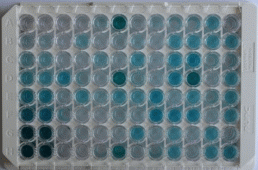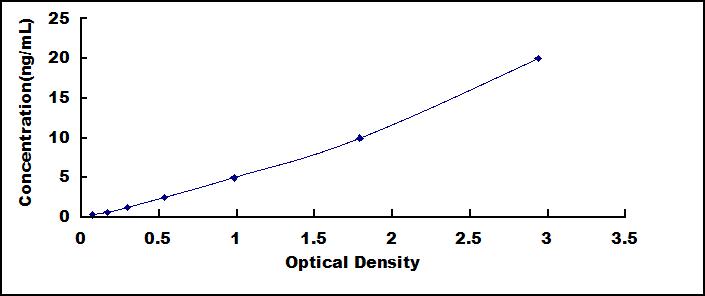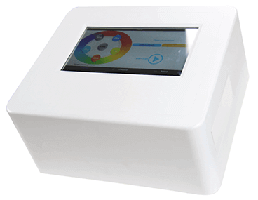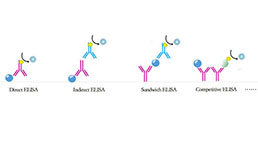Packages (Simulation)

Reagent Preparation

Image (I)
Image (II)
Certificate


ELISA Kit for Angiostatin (ANG)
- Product No.SEB254Mu
- Organism SpeciesMus musculus (Mouse) Same name, Different species.
- Sample TypeSerum, plasma, tissue homogenates, cell lysates, cell culture supernates and other biological fluids
- Test MethodDouble-antibody Sandwich
- Assay Length3h
- Detection Range0.312-20ng/mL
- SensitivityThe minimum detectable dose of this kit is typically less than 0.134ng/mL.
- DownloadInstruction Manual
- UOM 48T96T 96T*5 96T*10 96T*100
- FOB
US$ 479
US$ 684
US$ 3078
US$ 5814
US$ 47880
For more details, please contact local distributors!
Specificity
This assay has high sensitivity and excellent specificity for detection of Angiostatin (ANG).
No significant cross-reactivity or interference between Angiostatin (ANG) and analogues was observed.
Recovery
Matrices listed below were spiked with certain level of recombinant Angiostatin (ANG) and the recovery rates were calculated by comparing the measured value to the expected amount of Angiostatin (ANG) in samples.
| Matrix | Recovery range (%) | Average(%) |
| serum(n=5) | 87-94 | 90 |
| EDTA plasma(n=5) | 82-97 | 93 |
| heparin plasma(n=5) | 89-98 | 93 |
Precision
Intra-assay Precision (Precision within an assay): 3 samples with low, middle and high level Angiostatin (ANG) were tested 20 times on one plate, respectively.
Inter-assay Precision (Precision between assays): 3 samples with low, middle and high level Angiostatin (ANG) were tested on 3 different plates, 8 replicates in each plate.
CV(%) = SD/meanX100
Intra-Assay: CV<10%
Inter-Assay: CV<12%
Linearity
The linearity of the kit was assayed by testing samples spiked with appropriate concentration of Angiostatin (ANG) and their serial dilutions. The results were demonstrated by the percentage of calculated concentration to the expected.
| Sample | 1:2 | 1:4 | 1:8 | 1:16 |
| serum(n=5) | 93-101% | 92-99% | 78-98% | 88-96% |
| EDTA plasma(n=5) | 90-98% | 97-105% | 82-90% | 78-89% |
| heparin plasma(n=5) | 87-96% | 80-104% | 79-89% | 83-93% |
Stability
The stability of kit is determined by the loss rate of activity. The loss rate of this kit is less than 5% within the expiration date under appropriate storage condition.
To minimize extra influence on the performance, operation procedures and lab conditions, especially room temperature, air humidity, incubator temperature should be strictly controlled. It is also strongly suggested that the whole assay is performed by the same operator from the beginning to the end.
Reagents and materials provided
| Reagents | Quantity | Reagents | Quantity |
| Pre-coated, ready to use 96-well strip plate | 1 | Plate sealer for 96 wells | 4 |
| Standard | 2 | Standard Diluent | 1×20mL |
| Detection Reagent A | 1×120µL | Assay Diluent A | 1×12mL |
| Detection Reagent B | 1×120µL | Assay Diluent B | 1×12mL |
| TMB Substrate | 1×9mL | Stop Solution | 1×6mL |
| Wash Buffer (30 × concentrate) | 1×20mL | Instruction manual | 1 |
Assay procedure summary
1. Prepare all reagents, samples and standards;
2. Add 100µL standard or sample to each well. Incubate 1 hours at 37°C;
3. Aspirate and add 100µL prepared Detection Reagent A. Incubate 1 hour at 37°C;
4. Aspirate and wash 3 times;
5. Add 100µL prepared Detection Reagent B. Incubate 30 minutes at 37°C;
6. Aspirate and wash 5 times;
7. Add 90µL Substrate Solution. Incubate 10-20 minutes at 37°C;
8. Add 50µL Stop Solution. Read at 450nm immediately.
GIVEAWAYS
INCREMENT SERVICES
| Magazine | Citations |
| Science Alert | Antiangiogenic Activities of Cinnamon, Black and Green Tea Extracts on Experimentally Induced Breast Cancer in Rats Scialert: Source |
| Respiratory Research | Strain variation in response to lung ischemia: role of MMP-12 PubMed: 23061826 |
| Blood biomarker for early blood brain barrier disruption in ischemic stroke patent:US20170199205A1 | |
| Biomedicine & Pharmacotherapy | Development of a novel bivalent baculovirus vectors for complement resistance and sustained transgene expression and its application in anti-angiogenesis … |
| Catalog No. | Related products for research use of Mus musculus (Mouse) Organism species | Applications (RESEARCH USE ONLY!) |
| RPB254Mu01 | Recombinant Angiostatin (ANG) | Positive Control; Immunogen; SDS-PAGE; WB. |
| PAB254Mu01 | Polyclonal Antibody to Angiostatin (ANG) | WB |
| FAB254Mu01 | Anti-Angiostatin (ANG) Polyclonal Antibody | FCM |
| LAB254Mu81 | FITC-Linked Polyclonal Antibody to Angiostatin (ANG) | WB; IHC; ICC; IF. |
| LAB254Mu71 | Biotin-Linked Polyclonal Antibody to Angiostatin (ANG) | WB |
| SEB254Mu | ELISA Kit for Angiostatin (ANG) | Enzyme-linked immunosorbent assay for Antigen Detection. |
| LMB254Mu | Multiplex Assay Kit for Angiostatin (ANG) ,etc. by FLIA (Flow Luminescence Immunoassay) | FLIA Kit for Antigen Detection. |













